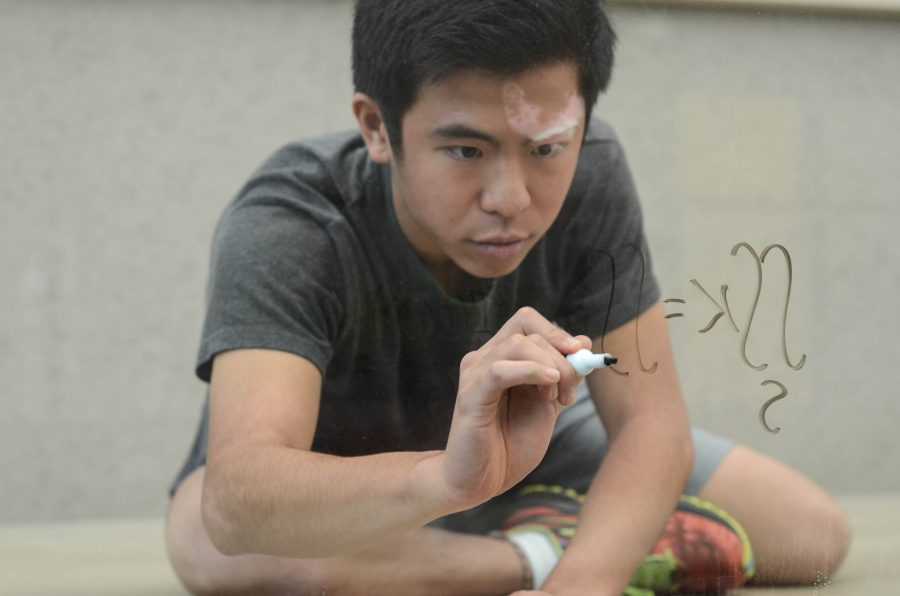Humans of Harker: Kai Ang likes to challenge himself with complex math problems
“Solving problems is a struggle, but it’s really rewarding when you put the stuff together. It seems like magic sometimes. Once I learn something really cool, I’ll write it in a handout. I guess the point of writing a paper and teaching would be to just share what I know and share my excitement,” Kai Ang (12) said.
October 31, 2016
To Kai Ang (12), being “good” at math doesn’t necessarily mean finishing problems first. His level of expertise lies not in rote calculations or speed competitions, but in the most complex problems that challenge him even without a time limit.
“I’m very bad at being super fast and being a human calculator,” he said. “I’m much better at thinking about problems and making connections between things and explaining how I got to where I got. That’s why I prefer the more open-ended [competitions].”
Beyond the various competitions, Kai does college-level math research. At Stanford University Mathematics Camp (SUMAC) the summer of his sophomore year, he compiled a proof of Polya’s Recurrence theorem using parts of papers and his own logic.
“We’re going to do some random walks in several dimensions,” he said in his description of the problem. “The first dimension is just a number line, and we start at the place zero. We’re going to take a number of steps, infinitely many, and for each step you either go right one or left one, and that’s random. Polya’s recurrence theorem says that we’re going to return to where we started eventually. Then you do this for two dimensions, like on a coordinate grid… and you’re still going to return to where you started.”
But at three dimensions and higher, these one-step walks will not necessarily return to the starting point. While the logic may seem intuitive—more dimensions equals more ways to stray from the origin—proving it requires combinatorics and probability, generating functions, inequalities, calculus and asymptotic approximations.
“In the math that’s beyond [the high-school level], there are a whole different bunch of areas of math, and they’re all interconnected in weird ways,” Kai said. “It’s endless.”
After he solves a problem, Kai doesn’t keep it to himself. As president of Math Club, he found an outlet for sharing his passion for math with students of all skill levels.
“[Kai’s] set up a really elaborate system of classes where anyone who’s interested in contest-style math problems can just drop in and learn new things every week,” Math Club officer Jimmy Lin (11) said. “He’s certainly opened it up to people who are less experienced in math competitions but are willing to learn. Whenever he’s teaching someone, he genuinely cares about their understanding and he wants to make sure that they see a topic at the same level of depth that he does.”
Kai describes himself as a truth-seeker, constantly looking to build connections between the truths he’s already established.
“Solving problems is a struggle, but it’s really rewarding when you put the stuff together. It seems like magic sometimes,” Kai said. “Once I learn something really cool, I’ll write it in a handout. I guess the point of writing a paper and teaching would be to just share what I know and share my excitement.”


















![“[Building nerf blasters] became this outlet of creativity for me that hasn't been matched by anything else. The process [of] making a build complete to your desire is such a painstakingly difficult process, but I've had to learn from [the skills needed from] soldering to proper painting. There's so many different options for everything, if you think about it, it exists. The best part is [that] if it doesn't exist, you can build it yourself," Ishaan Parate said.](https://harkeraquila.com/wp-content/uploads/2022/08/DSC_8149-900x604.jpg)




![“When I came into high school, I was ready to be a follower. But DECA was a game changer for me. It helped me overcome my fear of public speaking, and it's played such a major role in who I've become today. To be able to successfully lead a chapter of 150 students, an officer team and be one of the upperclassmen I once really admired is something I'm [really] proud of,” Anvitha Tummala ('21) said.](https://harkeraquila.com/wp-content/uploads/2021/07/Screen-Shot-2021-07-25-at-9.50.05-AM-900x594.png)







![“I think getting up in the morning and having a sense of purpose [is exciting]. I think without a certain amount of drive, life is kind of obsolete and mundane, and I think having that every single day is what makes each day unique and kind of makes life exciting,” Neymika Jain (12) said.](https://harkeraquila.com/wp-content/uploads/2017/06/Screen-Shot-2017-06-03-at-4.54.16-PM.png)








![“My slogan is ‘slow feet, don’t eat, and I’m hungry.’ You need to run fast to get where you are–you aren't going to get those championships if you aren't fast,” Angel Cervantes (12) said. “I want to do well in school on my tests and in track and win championships for my team. I live by that, [and] I can do that anywhere: in the classroom or on the field.”](https://harkeraquila.com/wp-content/uploads/2018/06/DSC5146-900x601.jpg)
![“[Volleyball has] taught me how to fall correctly, and another thing it taught is that you don’t have to be the best at something to be good at it. If you just hit the ball in a smart way, then it still scores points and you’re good at it. You could be a background player and still make a much bigger impact on the team than you would think,” Anya Gert (’20) said.](https://harkeraquila.com/wp-content/uploads/2020/06/AnnaGert_JinTuan_HoHPhotoEdited-600x900.jpeg)

![“I'm not nearly there yet, but [my confidence has] definitely been getting better since I was pretty shy and timid coming into Harker my freshman year. I know that there's a lot of people that are really confident in what they do, and I really admire them. Everyone's so driven and that has really pushed me to kind of try to find my own place in high school and be more confident,” Alyssa Huang (’20) said.](https://harkeraquila.com/wp-content/uploads/2020/06/AlyssaHuang_EmilyChen_HoHPhoto-900x749.jpeg)











Rajiv • Nov 2, 2016 at 4:40 pm
This piece was very well written, Melissa!